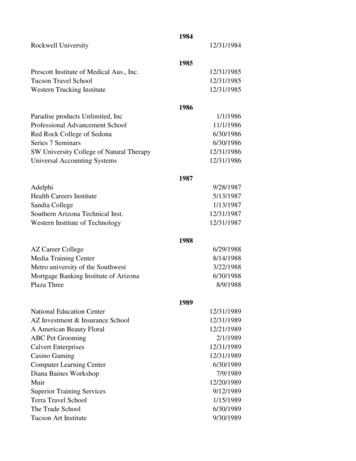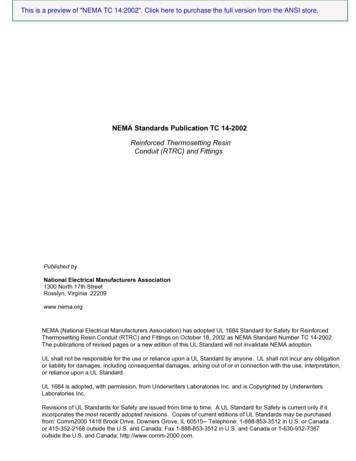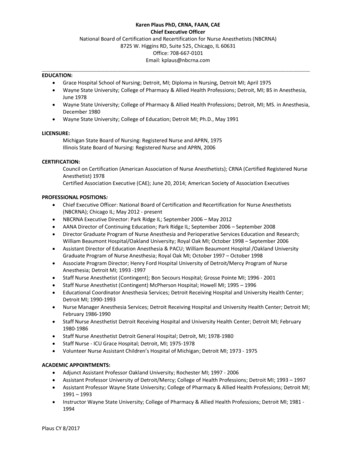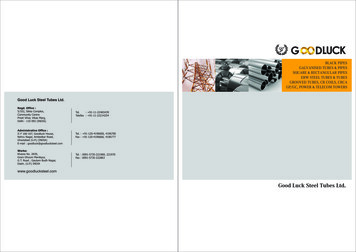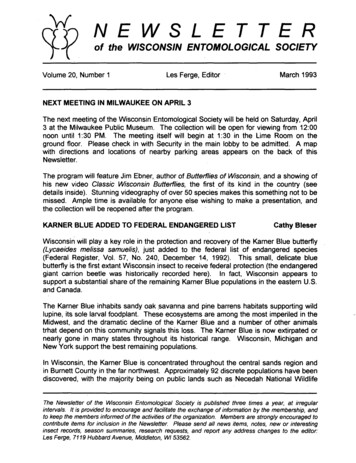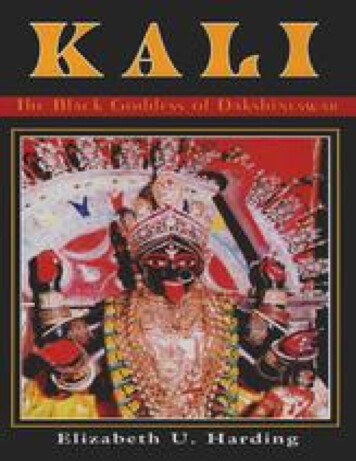
Transcription
First published in 1993 byNicolas-HaysP. O. Box 1126Berwick, ME 03901-1126Distributed to the trade byRed Wheel/Weiser, LLCP. O. Box 612York Beach, ME 03910-0612With offices at368 Congress St., 4th FI.Boston, MA 02210www.redwheelweiser.comCopyright 1993 Elizabeth U. HardingAll rights reserved. No part of this publication may be reproduced ortransmitted in any form or by any means, electriconic or mechanical,including photocopy, or stored in any information retrieval system withoutpermission in writing from Nicolas-Hays, Inc. Reviewers may quote briefpassages.Library of Congress Cataloging-in-Publication DataHarding. Elizabeth U.Kali : the black Goddess of Dakshineswar / by Elizabeth U. Hardingp. cm.Includes bibliographical references and index.ISBN 0-89254-025-7 : 14.951. Kālī (Hindu deity) 2. Dakshineswar Kali Temple. 3. Kālī (Hindu deity)-Cult--India—Dakshineswar. 4. Dakshineswar (India)--Religious life andcustoms. I. Title.BL1225.K3H29 1993294.5'2114—dc20
93-15021CIPBJCover photograph copyright 1993 Gandhi RoyTypeset in 11 point PalatinoPrinted in the United States of America12 11 1013 12 11 10 9 8 7The paper used in this publication meets the minimum requirements of theAmerican National standard for permanence of paper for printed librarymaterials. er.com/newsletter
I offer this book at the feet of Ma Kali with reverence, and I dedicatethis book to my mother, a remarkable catholic woman who livedthrough two world wars, the Great Depression, 45 years of familyoppression and never lost her sweet love, kindness and belief in thegoodness of others.
ContentsList of IllustrationsPrefaceJai Kali, Jai Ma BhavatariniAcknowledgmentsINTRODUCTIONGod, the MotherCHAPTER 1The Dakshineswar Kali TempleCHAPTER 2Kali, the Black Goddess of DakshineswarCHAPTER 3Worship of KaliCHAPTER 4Temple History and SurroundingsCHAPTER 5Ma Kali's God-Intoxicated MysticsIN SUMMARYGlossaryBibliographyIndexKali MandirAbout the Author
List of IllustrationsFigure 1. KaliFigure 2. The main gate to the Dakshineswar Temple compoundFigure 3. Approaching the Dakshineswar Kali Temple from the GangesFigure 4. The Dakshineswar Kali TempleFigure 5. Waiting to see the Divine Mother KaliFigure 6. DevoteesFigure 7. Devotee reverently touches the stepsFigure 8. People pushing toward the front entranceFigure 9. Kali bedecked with flowersFigure 10. Shiva with Kali standing on his chestFigure 11. Smashan KaliFigure 12. Kali's inner shrineFigure 13. Krīm, seed mantra of the Goddess KaliFigure 14. The Kali YantraFigure 15. Goddess Kali after vesper servicesFigure 16. Map of the Dakshineswar Kali TempleFigure 17. The Vishnu TempleFigure 18. Raghuvir shalagramFigure 19. KrishnaFigure 20. The break in Krishna's legFigure 21. The Shiva temples of DakshineswarFigure 22. Devotees enter the Shiva TempleFigure 23. Rani RasmaniFigure 24. Mathur Nath BiswasFigure 25. Beggars line up near Kali Temple
Figure 26. Sri Ramakrishna's roomFigure 27. An old painting of Sri RamakrishnaFigure 28. View from Sri Ramakrishna's roomFigure 29. The Banyan tree of the PanchavatiFigure 30. A priest performs daily worshipFigure 31. Shankar ChatterjeeFigure 32. Sri RamakrishnaFigure 33. The bells of Vishnu, Kali, and Shiva Temples call devotees toevening aratiFigure 34. BamakhepaFigure 35. The holy feet of Ma Tara in TarapithFigure 36. Sri Sarada DeviFigure 37. Swami Vivekananda
PrefaceKali, the Divine Mother, has been largely misunderstood in the West. As aresult, people have labeled her as something evil rather than a source of joy.Up close, the concept of Kali is no more startling than the Christian practiceof partaking of Christ's body and drinking his blood during communion.This book attempts to clarify who Kali is and to make the reader feel what itis like to be in India and experience Kali. What does Kali mean to me?In order to read this book, one does not have to be familiar with Hinduphilosophy. I have tried to acquaint the reader with the Hindu concept ofGod, the Mother, through stories, historic references, an overview oftraditional philosophy, and vivid descriptions of the Dakshineswar KaliTemple—the place and its people.The reader becomes the pilgrim, sharing the excitement and preparationof other pilgrims on the way to see the Divine Mother Kali. Besides gettinga glimpse of the Hindu attitude toward this Mother Goddess, one gets usefulinformation about customs at the Dakshineswar Kali Temple—what to dowhen one arrives there and why.The third chapter explains the symbolism of Kali and how she is seen bypeople from different cultures, following different philosophies. It gives adetailed description of the Dakshineswar Kali image and her inner shrine,which is off limits for most people. It looks at the Mother Goddessaccording to Tantric and Vedantic views. An ongoing commentary by SriRamakrishna (taken from The Gospel of Sri Ramakrishna), the Kali saintwho lived in Dakshineswar, helps the reader perceive the Goddess in herMother aspect.The fourth chapter is dedicated to the worship of Kali, the general conceptof Hindu worship and the worship as it is performed at the DakshineswarKali Temple—on a daily basis and on special occasions.I found it impossible to write about the Dakshineswar Kali Templewithout mentioning Rani Rasmani, the woman who built it. She was a greatdevotee of Kali. She was very beautiful and, though born poor and of lowcaste, married an extremely rich man. Upon his death, she decided to take on
the responsibility of managing his vast wealth and to build a temple to herbeloved Mother Kali. This took tremendous courage since the time was theearly 1800s, when women, especially those of low caste, had no place insociety except beside their husbands. The Rani's view was catholic—shebuilt a Vishnu temple and twelve Shiva temples in the same compound.(Kali and Vishnu followers often do not get along—Shaktas eat meat whileVaishnavites are strict vegetarians.)The last chapter is devoted entirely to Kali's mystics, the people whoattained the highest realization by worshipping Kali. Though the saintsmentioned in this chapter lived mostly in West Bengal in India, theircolorful lives, their convictions, and their approach toward the ups anddowns of life have a global appeal.The absence of Westerners among Kali saints in this book does notindicate that great devotees of Kali can only be found in India. Since I beganworking on this book, I met many wonderful people in the USA who aredevoted to Kali. The more I learn about this Great Goddess, the more I feelmy understanding of her has just begun and will continue, perhaps, alifetime.Elizabeth U. Harding
Jai Kali, Jai Ma Bhavatarini[Victory to Kali, victory to the Mother, the Savior of souls]We prostrate before herwho is at once most gentle and most terrible;We salute her again and again.Salutation to her who is the support of the world.Salutations again and againto the Devi who abides in all beings in the form of consciousness;to the Devi who abides in all beings in the form of intelligence;to the Devi who abides in all beings in the form of sleep;to the Devi who abides in all beings in the form of hunger;to the Devi who abides in all beings in the form of power;to the Devi who abides in all beings in the form of modesty;to the Devi who abides in all beings in the form of peace;to the Devi who abides in all beings in the form of faith;to the Devi who abides in all beings in the form of loveliness;to the Devi who abides in all beings in the form of compassion;to the Devi who abides in all beings in the form of contentment;to the Devi who abides in all beings in the form of mother.May that Devi, the Mother, who appears in the form of all things,bring forth benefits for all who sing her praises.—Chandi
AcknowledgmentsI am indebted to so many people who gave me support and kindly helped mewith my research. I want to thank my spiritual teacher, SwamiChetanananda, for being an inspiration and for making valuable suggestionsafter reading the manuscript. I want to thank Swami Gambhirananda, thelate President of the Ramakrishna Order, who, like a father, blessed me andencouraged me to work on this project. I also want to thank SwamiAtmaramananda, Swami Gambhirananda's secretary, who read themanuscript and made corrections.I am especially indebted to Mrs. Kalpana Biswas, a member of the RaniRasmani family. Without her help, my photographs of Kali—as well as thisbook—would not have been possible. My special thanks go to the priests ofthe Dakshineswar Kali Temple. Pranab Ghosal was of invaluable help. I amindebted to Haradhan Chakraborti, Mohan Chatterjee, Chayan KumarGanguly, Dipu, Dwiju and all others who supplied me with valuableinformation concerning Mother worship at the temple. My thanks also go tothe Dakshineswar Kali Temple trustees, to the members of the RaniRasmani family, the temple office staff and to all Kali devotees who helpedwith this project.I thank the publishers mentioned in this book for giving me permission touse their material. I am especially grateful to Swami Adishwarananda for thepermission to use many quotations from The Gospel of Sri Ramakrishna,Swami Smaranananda for quotes from Sri Ramakrishna, The Great Master,and Mr. Amiya Kumar Sinha for poems from Ramaprasada's DevotionalSongs.
INTRODUCTIONThe Divine Mother's magic is ancient as life itself.She existed before gods and mortals, and she will still exist evenafter the great dissolution.Mother is pure energy in subtle form, but in times of need or justout of a desire to play, she manifests.God, the MotherWhen the Gods lay exhausted after warring with the demons, the evilnatured demon king Mahishasura took the opportunity to assemble an armyand declare himself Lord of Heaven, Ruler of the Universe.This blasphemy reached Vishnu's ears and, in anger, he shot forth aterrible light from his forehead. Shiva, too, was angry. He descended fromhis lofty state of meditation and beamed a sharp ray of blinding light in thesame direction as Vishnu. Brahma, Indra and the other mighty Gods didlikewise, each issuing forth piercing rays of light. All the Gods' rays joinedat one point and, slowly, the blazing concentration of light took shape in theform of a woman.The light of Shiva formed her face, Yama gave her hair and Vishnu herarms. From the light of Chandra, the moon God, her two breasts wereformed. Indra modelled her waist and Varuna her thighs. Earth gave her hipsand Brahma feet. The light from the fire God, Agni, fashioned her threeeyes. Thus, all Gods contributed their power to manifest the auspiciousDevi, the great Mother Goddess.1As soon as the Devi was fully formed, the Immortals prayed to her andworshipped her with praise, ornaments and weapons. Shiva gave her atrident drawn forth from his own, Vishnu a powerful discus, and Indra, theking of the Gods, gave her a thunderbolt identical to his own. Surya, the sunGod, bestowed his rays on all the pores of her skin, and Varuna, god of theocean, gave her a divine crest jewel, earrings, bracelets and a garland ofunfading lotuses.“Victory to the Mother,” shouted the Gods as they watched the demon
battalions approach with the beating of drums, battle cries, and the blowingof conches. Since the Devi was of enormous size and highly visible, thedemons marched straight toward her, attacking from all sides with arrows,clubs, swords, and spears.Figure 1. Kali.Unperturbed, the Devi roared loudly and laughed a frightening, defiantlaugh. Again. And again. And then her ten arms rotated, alternatelysmashing weapons of the demons and hurling them back at her attackers.With great ease, she picked up dozens of demons at once, killing them withher sword. Some demons she didn't even bother to pick up. She stupefiedthem with the tremendous noise of her bell and then crushed them with hermace.The demon Raktabija gave the fierce Mother Goddess a fair amount oftroubles. He possessed a special magical power which allowed him to createnew demons from his own blood. Whenever the Goddess wounded him,
each drop of blood that spilled to the ground sprouted another demon full ofstrength and brutality. But in the end the Mother outwitted him. She pickedup Raktabija and lifted him high into the air to avoid spilling his blood onthe ground, and then, gnashing him between her teeth, she drank his bloodand swallowed him whole. See figure 1.Other demons, too, tried to confuse the Goddess with their magicalpowers. Whenever they were threatened by the Devi, they changed theirform and color. But, who can escape the great Mother? Bound by her nooseand spitting blood, these demons were soon caught by the Devi. And like achild pulling a toy train, she dragged them over the battlefield where scoresof demons already lay split into two by the sharp slashes of her sword.Snatching some elephants with one hand, the Devi flung them into hermouth and, together with the demon drivers, she furiously ground them upwith her teeth. She seized one demon by the hair and another by the neck.One she crushed by the weight of her foot and another with her body.The Mother's terrible presence filled even the sky. Black clouds gatheredand terrifying lightning lit up the ghastly shapes on the ground. There weredemons without arms, without legs, demons torn asunder in the middle oftheir trunks.When Mahishasura, the king of the demons, saw his army devastated bythe blows of the terrible Mother Goddess, his fury knew no bounds. Heexpanded his body to take on the fierce shape of a giant buffalo. Intoxicatedwith his own strength and valor, he roared and charged toward the Devi.“Roar, roar, O fool,” shouted the Goddess. “Roar for a moment. Whenyou are slain by me, the Gods will soon roar in this very place.”The earth began to tremble under the stomping feet of the Goddess.Mahishasura fought with all his might but could not conquer the Devi. So heappealed to her sense of justice, complaining that she fought in an unfairway. The Devi, he claimed, received help from so many fierce Goddesses—Durga, Kali, Chamunda, Ambika, and others— and he, Mahishasura, had tofight all by himself.“I am all alone in the world here,” thundered the Devi. “Who else is therebesides me? See, Î vile one, these Goddesses are but my different powerswhich again enter into my own self. I stand alone. Don't back off; defendyourself.”
The savage fight continued, and the great demon attacked the MotherGoddess with showers of arrows. He hurled discuses, swung his clubs andmace. To no avail. The Devi killed him with her spear, releasing the soulfrom its evil-natured body and mind.Dust clouds carried the stench of singed skin and rotting flesh to theblood-red horizon. The demons had been killed, and their blood flowed,accumulating here and there in small pools around carcasses of elephantsand horses. Only some headless torsos of demons who refused to give uplife still fought the Devi. The battle shrieks had died and the only cries nowwere those of jackals and hyenas. There was nothing left to kill, but theblood-intoxicated Mother in the form of Kali continued the carnage—smashing and slashing dead demons all over again.The Gods, who had begun to celebrate victory, became filled with fear.Who was going to stop her? There was only one who could: Shiva, the greatGod. Besmeared with ashes, the third God of the Hindu Trinity went to thebattlefield and lay down motionless among the corpses while the rest of theGods watched from a safe distance.The intoxicated Devi staggered across corpses until, suddenly, she foundherself standing on top of a beautiful male body—nude and besmeared withwhite ashes. Awed, she stood still for a moment, looked down at him, andsaw straight into the eyes of her husband Shiva. When she realized that shewas touching her divine husband with her feet—an unthinkably disrespectfulact for a Hindu wife—Kali stretched out her tongue in shame and thedestruction came to an end.The ancient legend of the Devi, the great Mother Goddess, has been handeddown by generations of Hindus and stems from a sacred book of the ShaktaTantras, called the Chandi. Although it is understood that the tale'sbewildering gore and sentimentality are allegorical, one still wonders what itmeans to Hindu society today.From a religious as well as a social standpoint, this legend reaffirms theprotecting power of the archetypal Mother who is an integral part of Hinduhouseholds. In the West, the woman in the family is mostly seen in her roleas the wife, while in India, the woman of the house is always the “mother.”Even an unmarried woman without children is often addressed as “mother.”
It is a gesture of respect, because Hindus consider the position of a motheras supreme.Hindus, especially in Bengal, worship the great Mother with ceremoniesof great splendor. Once a year during an autumn festival called Durga Puja,they reenact the story of the fierce protectress and, side by side, intellectualsand illiterates worship the Mother in temples, homes and in makeshiftpandals in the street. In return for their efforts, the great Mother reassuresthem every year that the good will always overpower the bad—eventually.From a philosophical standpoint, this legend is an allegoricalrepresentation of the constant war going on within all of us—between ourdivine and demonic natures. In the great Mother Goddess legend, everydominant passion and vice has its special demon representative: Sumbha isthe embodiment of lust, Nisumbha is greed, and Mahishasura representsanger.The Indian scholar Sashi Bhusan Das Gupta wrote an article called“Evolution of Mother Worship in India.” He said:Whenever our passions are in danger of being eradicated orsuppressed, they change their form and color and try to escape indisguise. This has been illustrated by the story of some of the demonschanging their shape when challenged by Shakti, the divine Power.Our passions and instincts are so deeply rooted in us that they oftenseem to be indestructible, since one that is killed is replaced at once byanother, and so on. This is well illustrated by the Goddess' fight withthe demon Raktabija, from whose every drop of blood shed on theground sprouted a demon with fresh vigor and ferocity. It is theawakening of the Mother within, that is, full consciousness of thedivine Power working in and through him, that makes man strong andsurcharged with the immense power of God.2Some Hindus talk about their great Mother Goddess with the vehemenceof a child who threatens another child while wrestling for a toy: “My motherwill punish you if you don't give it to me!” This strong belief in a Goddessthat takes care of one's earthly and spiritual wants appears childish to somepeople living in a rational, grown-up world.But if we dig through our carefully built-up layers of society-dictated
values, most of us will admit that somewhere deep in the heart is a very softspot reserved for our earthly as well as archetypal mother. Great peoplethroughout history have believed in a powerful Mother Goddess as thegoverning force in the universe. Take, for example, Swami Vivekananda. Hebecame famous in the East and the West for teaching the highest form ofVedanta—Aham brahmasmi (I am Brahman, I am God). Don't bow down toany other God except to the Self within you. Yet, even the high-minded,rational Swami Vivekananda had to acknowledge Mother Kali. On rareoccasions, he spoke to special devotees about his inner passion for theDivine Mother. The following is transcribed from a talk that SwamiVivekananda gave to a small group of people assembled in a woodencottage in Thousand Island Park:Mother is the first manifestation of power and is considered a higherideal than Father. The name of Mother brings the idea of Shakti,Divine Energy and Omnipotence; the baby believes its mother to beall-powerful, able to do anything. The Divine Mother is the Kundalinisleeping in us; without worshipping Her we can never knowourselves. All-merciful, all-powerful, omnipresent—these areattributes of the Divine Mother. She is the sum total of the energy inthe universe. Every manifestation of power in the universe is Mother.She is life, She is intelligence, She is love. She is in the universe, yetseparate from it. She is a Person and can be seen and known—as SriRamakrishna saw and knew Her. Established in the idea of Mother,we can do anything. She quickly answers prayer.She can show Herself to us in any form at any moment. The DivineMother can have form, rupa, and name, nama, or name without form;and as we worship Her in these various aspects, we can rise to PureBeing, having neither form nor name. . .A bit of Mother, a drop, was Krishna; another was Buddha; anotherwas Christ. The worship of even one spark of Mother in our earthlymother leads to greatness. Worship Her if you want love andwisdom.3The Evolution of Mother Worship in IndiaWorshipping the mother as God is a most natural thing to do. Belief in a
Mother Goddess can be found in almost all races and religions, andespecially in ancient history the Mother Goddess played an important role.Considering that the first being a child relates to is its nurturing mother, andconsidering that primitive people who had no scientific knowledge musthave watched the miracle of birth with wonder and awe, it comes as nosurprise that our remote ancestors greatly revered the mother. When ancientpeople began to conceive of a higher supernatural being that would nourishand protect them from evil, they naturally conceived it in the image of amother.As we evolved, we began to understand that there cannot be any creationunless there is the union of two—the male and the female. Extending humananalogy to the creation of the universe as a whole, we came to believe in aPrimordial Father and a Primordial Mother which formed the first pair. Allthe pairs in the universe are said to be replicas of this original pair.In India from the age of the Indus Civilization of Mohenjo-daro andHarappa down to the present time, the Father God is represented bythe linga (the male symbol) and the Mother Goddess by the yoni (thefemale symbol). This representation of Shiva-Shakti by the linga-yoniis a popular religious practice in India, and in most of the ancient andmodern temples of Shiva, the twins are worshipped in their symbolicrepresentations. In the Tantra literature (both Hindu and Buddhist) theLord (Bhagavan, the male deity) is symbolically represented by awhite dot (shweta-bindu), thus suggesting the likeness with semen,while the Creatrix (Bhagavati, the female deity) is represented by ared dot (shona-bindu), to suggest the analogy with the menstrual bloodcontained in the ovum.4India has many places famous for Mother worship, but Hindus considerespecially sacred those where pieces of the Devi's body fell in hermanifestation as Sati.According to legend, the Divine Mother in the form of Sati married Shivaagainst the will of her father Daksha. Since he thought of Shiva as amarijuana-smoking, good-for-nothing beggar, Daksha not only refused toaccept him into his family, but also denounced Sati and forbade her to returnto his kingdom.For many years, Shiva and Sati lived happily on Mount Kailas, high up in
the Himalayas. Until, one day, the sage Narada arrived with the news thatDaksha was planning a big festival and sacrifice which all Gods and theirfamilies were asked to attend. Neither Shiva nor Sati had been invited. UponSati's insistence to attend the sacrifice, Shiva gave in and asked his carrier,the old bull Nandi, to take Sati to her father's court.Upon arrival, Sati was glad to see her father after such a long absence.She was about to embrace him, but he pushed her away.“Why did you come here? A beggar's wife!” shouted Daksha. He thenproceeded to curse Shiva.Sati blushed deeply.“Words such as these, the faithful wife must never hear,” said Sati. “Myears have listened to you and are now defiled. You gave me life. Now, takeit back. I shall not keep it after such dishonor.” All color drained from herbody and she fell dead at Daksha's feet.The attendant Nandi sadly returned to Kailas and told Shiva about hiswife's death. Shiva's instant grief and wrath were beyond control. He shookhis matted locks and out of them leapt a whole army of giants, snakes andghosts. They turned Daksha's palace to ashes in no time.Meanwhile, Shiva picked up the dead body of Sati and, bearing it uponhis shoulders, he began a terrible dance of destruction. His footsteps shookthe world, causing earthquakes and tidal waves that threatened extinction toall.To save mankind, Vishnu hurled his discus again and again at Sati'scorpse until her body fell to the earth, piece by piece. It took fifty-onethrows to destroy Sati's body. As soon as Shiva felt her weight gone, hewithdrew to Kailas and solitary meditation. He became so absorbed that theDivine Mother, reborn later as Uma, had difficulty in arousing him to forgetSati and marry her.Wherever the fragments of Sati's body had fallen to the earth, theysprouted sacred Shakti pithas (places dedicated to Mother worship). Ancienttemples stand on these spots and, daily, hundreds of pilgrims come to paytheir homage to the great Mother. Sati's toes fell to the earth at Kalighat inSouth Calcutta, and she is worshipped there as Mother Kalika. The gem ofSati's earring fell on Manikarnikaghat in Benares. Sati's right and left breastsfell at Jalandhara and Ramgiri— she is worshipped there as Tripuramalini.
Sati's sexual organ (yoni) fell at Kamakhya in Assam.The Kamakhya Temple is one of the most famous temples dedicated toMother worship and is especially associated with disciplines practicedaccording to Tantra.5 It houses the Mother's image in the form of a yonishaped cleft in a rock that hides a natural spring, keeping the cleft moist.Tantrics say that the earth's menstruation takes place there in the Hindumonth of Asar (around July/August).During Ambuvachi6 (July-August), after the first burst of themonsoon, a great ceremony takes place, for the water runs red withiron-oxide, and the ritual drink is symbolic of the rajas or ritu of theDevi, her menstrual blood.7Widows do not eat cooked food for three days during this period nor do theycook for anybody else.In the Shakti pithas across India, traditions differ somewhat and theGoddess' name varies with each location. The Divine Mother likes to playdifferent roles. When Sati had trouble getting permission from Shiva toattend the sacrifice arranged by her father Daksha, she showed herself tohim in ten terrible forms, known as the dashamahavidya. Sati became, oneafter another—Kali, Tara, Sodasi, Bhuvanesvari, Chinnamasta, Bhairavi,Dhumavati, Bagala, Matangi and Kamala. She so successfully terrorizedMahadeva (the great God) that he gave in to her wishes.Each of these ten Goddesses has a specific universal function. The blackKali is the embodiment of time—the primordial energy. Tara, of dark bluecolor, personifies the power of aspiration and spiritual ascent. Sodasirepresents perfection and Bhuvanesvari the infinite space. Both theseGoddesses appear in the color of the rising sun. Sodasi is a 16-year-old girlof reddish complexion who sits astride the prostrate body of Shiva.Bhuvanesvari nourishes the three worlds with her large breasts that oozemilk. Chinnamasta is the end of existence and wears the color of a millionrising suns. She stands in the cremation ground on the copulating bodies ofKama, the God of lust, and his wife Rati. Chinnamasta is shown decapitated,holding her own head while drinking her own blood that streams from herneck. Bhairavi is the embodiment of destruction; her complexion is red, andher breasts are besmeared with blood. The ashen-colored Dhumavati, clad indirty white clothes, is the night of cosmic slumber. Her hair is disheveled;
she has no teeth and her breasts are long and pendulous. Bagala, who is theembodiment of illusion, has a yellow complexion, and her head resemblesthat of a crane. Bagala holds a club in one hand while another pulls on ademon's tongue. Matangi dispels evil, and the color of her skin is black. Sheis intoxicated, reels about, and frightfully rolls her eyes. Kamala is beautiful,and her complexion is the color of lightning. Kamala, who reveals herself ingood fortune, is seated on a lotus. She is surrounded by elephants who pourpitchers of water over her.Aside from the Goddesses depicted in the dashama-havidya, there are somany other names and forms of the same Divine Mother. In the Devikavacha attached to the Chandi, the Mother Goddess as Navadurga isdescribed as Shailaputri (the daughter of the mountain), Brahmacharini,Chandraghanta, Kushmanda, Skandamata, Katyayani, Kalaratri, Mahagauriand Siddhidatri.Among the Mother Goddess' many shapes, the most popular are Parvati orUma, the daughter of the Himalayas; Durga, the powerful protectress who isseated on a lion; Lakshmi, the Goddess of fortune, seated on a lotus;Saraswati, the Goddess of learning, seated on a swan. The Divine Mothermanifesting as Chamunda is seated on a corpse, Varahi on a buffalo, Aindrion an elephant, and Vaishnavi on Garuda—the legendary large bird andcarrier of Vishnu. The Divine Mother as Narasimhi, Shivaduti, Maheshwari,and the white Goddess Ishwari is depicted as seated on a bull. As Kaumari,she sits on a peacock, and as Brahmi on a swan.Hindu imagination is vast, and one wonders how these particular carriersof Hindu Goddesses were selected. Weight seems to be of no importance.For instance, the Goddess Kaumari sits on a peacock, and the chubbyelephant God Ganesha has an even tinier carrier. Ganesha's bulky body sitson a mouse.But what most puzzles people in the West is the Hindu's preference ofworshipping Goddesses associated with gore. Even most liberal-mindedWesterners look upon Kali as terrible and cruel. She is killing the demonswho are also her children if she, indeed, is the Mother of the universe.“The Divine Mothe
Ramakrishna (taken from The Gospel of Sri Ramakrishna), the Kali saint who lived in Dakshineswar, helps the reader perceive the Goddess in her Mother aspect. The fourth chapter is dedicated to the worship of Kali, the general concept of Hindu worsh
